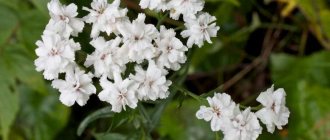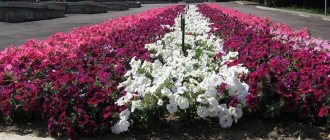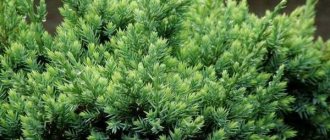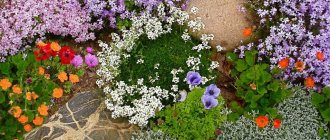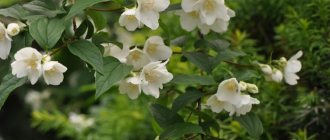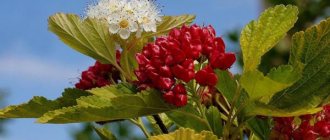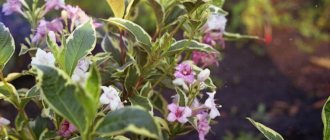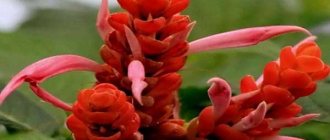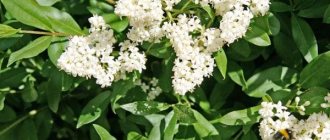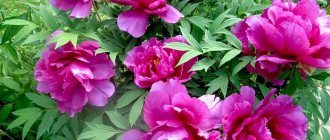Botanical description
Barberry bears fruit abundantly with large, often edible berries, which are used as food in many cuisines around the world. The elegant appearance of the ornamental plant is actively used in landscape design. Dwarf varieties of barberry are grown at home.
The plant does not require special care and attention, it has drought-resistant and frost-resistant qualities. It reproduces well by all popular gardening methods. It does not require constant fertilizing, rarely gets sick, and takes root well in any soil.
Gorgeous specimen with pinkish leaves
Barberry is called a candy bush at the suggestion of Soviet confectioners, who gave its name to their famous caramels. But if you look at the large, ripe and bright fruits of the plant, it’s really hard not to associate them with a sweet delicacy.
There are varieties with evergreen, partially deciduous and deciduous crowns. The leaves grow in bunches in regular order. Thin branches covered with thorns tend upward at an acute angle.
Depending on the type and variety, the shrub can reach a height of 30 cm to 3 m. The crown of the latter in adulthood acquires columnar, spherical or spreading outlines. The average age of an individual is 35-50 years.
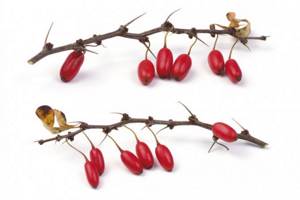
Sharp spines and ripe fruits
Barberry blooms in late spring and early summer in a bright palette of shades: violet, purple, red, pink, yellow, white, green, variegated. Flowering lasts 2-3 weeks. Towards the beginning of autumn, oblong oval-shaped berries, red, black or burgundy, appear.
The fruits do not spoil on the branches for a long time, even in winter diluting the snow-white landscape with the rich colors of summer. Most barberry species are honey plants. Fresh honey has a medium consistency, sweet taste and golden hue.
Popular types
The family includes more than 170 species of barberry. They all differ in the shape and color of the leaves, the height of the bush and the berries. But absolutely all have high frost-resistant qualities and can get along without problems in arid areas and even rocky soil in the mountains.
From this quantity, about 50 varieties of Thunberg barberry are distinguished, suitable for growing in the landscape design of personal plots, city parks, gardens, and even landscaping roadside areas. The plant tolerates dust and gas pollution well. The rating presents the best varieties with descriptions and photographs.
Erecta
A tall shrub with smooth vertical shoots covered with succulent foliage is called Erecta. Its branches are erect, directed upward and collected in a dense formation up to 150 cm high and 100 cm in diameter. The shoots are densely covered with green foliage and sparse thorns; in autumn the leaves turn orange and variegated red.
It blooms in early summer with yellow and red flowers collected in small inflorescences. In autumn, in their place, coral fruits form, which do not fall off for a long time and serve as a spectacular decoration for shrubs that are bare in winter.
The variety easily tolerates partial shade and does not lose its decorative qualities, has high frost resistance, can withstand temperatures down to -35, and does not require insulation. There is increased immunity to diseases such as powdery mildew and rust, to which most types of barberry are susceptible.
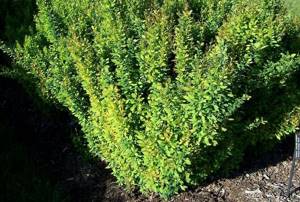
Bonanza gold
Unlike the previous variety, Bonanza is low-growing and has a lush, loose crown of lemon-golden color. The height of an adult bush barely reaches 50 cm, and the diameter of the crown is one meter. High resistance to various pests and diseases is noted, but does not tolerate shady areas and loses its unusually sunny color.
In spring it blooms with yellow buds, and by autumn it forms edible bright red fruits. It feels great in sunny meadows, protected from the wind, and in well-drained fertile soil; it grows well in acidic soils.
The variety is susceptible to aphids, moths, powdery mildew and sometimes rust. It tolerates winters calmly, but some of the shoots may freeze and require spring cleaning of the bush.
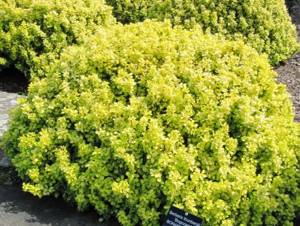
Aurea
Another variety with golden foliage is Aurea. The shrub is quite compact in size with a crown no more than 150 cm in diameter. The species tends to grow slowly, so its height is easily adjusted and maintained by annual pruning and pruning of old branches.
In summer, the bush seems to be filled with sunlight; its lush yellow-green foliage stands out effectively against the background of other plants and trees. And with the arrival of autumn there are warmer shades: orange, yellow, lemon. The variety has many dwarf hybrids, growing only 20 cm high and up to 40 cm wide.
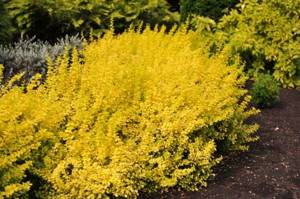
Red rocket
Translated from English, “red rocket” means “red rocket”. This name is due to the bright orange-red coloring of barberry foliage. The variety is quite tall, its maximum height is 2 meters, and its width is only 50-60 cm. This shape allows the shrub to be planted in the background of a rose garden or flower garden, and its rich color makes it even more expressive.
Red rocket goes well with its coniferous neighbors, standing out against their background with purple leaves. By mid-autumn, healthy and edible berries ripen, from which jams, compotes are prepared and dried as a spice.
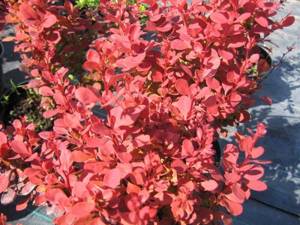
Coronita
A representative of dwarf varieties is the Koronita variety. It has a smooth, spreading crown and ovate leaves, colored dark purple. A characteristic feature is the yellow-green border along the contour of the leaves.
The bush does not grow higher than 1 meter, but it looks very impressive due to its exotic coloring. Used in wood compositions and as border decorations. As a representative of the Barberry family, it boasts high resistance to frost, drought and growing conditions. To preserve decorative coloring, it is recommended to plant it on the sunny side of the site.

In addition to the listed varieties, Thunberg barberry can boast of the following specimens:
- Kobold.
- Golden ring.
- Red Chief.
- Green Carpet.
- Admiration.
- Harlequin and others.
All varieties are unpretentious, grow quickly, are easy to propagate and look impressive against the background of other plants. Such pets always stay on trend and create a rather cozy environment.
Halo of growth
The plant is a typical inhabitant of almost the entire territory of the Northern Hemisphere, with the exception of permafrost latitudes. For decorative and cultural purposes, it is bred in Europe, the Far East, China, Japan, Central Asia, North America, the Caucasus, Persia, Siberia, and Crimea.
The shrub tolerates temperature changes typical of a temperate continental climate. Some varieties are insulated for the winter, others are quite frost-resistant. Heat is also not a big problem for barberry.

Luxurious palette of plant shades
Grows in any soil, even with a composition poor in nutrients. The small root system allows the tree to easily get along with other vegetation.
The main requirement for environmental conditions is the absence of stagnation of moisture in the roots and a sufficient amount of light.
Barberry tolerates drought much better than excess water. It is able to grow in the shade, but in this case the color of the foliage will not be bright and saturated. Fruiting will also not be abundant.
Popular types and varieties
According to modern taxonometry, the genus Barberry has almost 600 plant species. Most of them are bred for decorative purposes. This includes both giant plants and low-growing individuals.
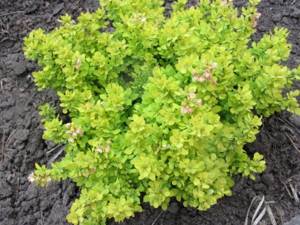
Dwarf representative of the genus
Many species are divided into separate varieties, which further increases the number of variations of the shrub. Let's look at popular varieties of barberry, the best for growing in Russian regions. Some of them are edible, others are grown for pharmacological, aesthetic and other purposes.
Thunberg
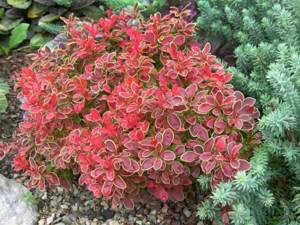
Thunberg Under natural conditions, the species grows in China and Japan. This is an elegant deciduous shrub whose crown color palette includes all shades of red, yellow, orange and green. It tolerates frost and drought well, is not afraid of pests, and grows in an urban environment in rocky soil without fertilizers.
- Thunberg Erecta . An erect, pyramidal bush with bright green leaves of regular, oval shape. The crown is thick and dense. The average height of an individual is 1.2-1.5 m. The flowers are yellow and pale red.
- Thunberg Admiration . A miniature, dwarf tree with a wide, round top, which can reach 1 meter in diameter. Moreover, the height of an adult specimen rarely exceeds 50 cm. The leaves have yellow, red and orange colors with a clear, light edging.
- Thunberg Coronite . Neat bushes up to one and a half meters high with vertical shoots. The oblong, soft pink leaves have a light green edge. The flowers are yellow, the fruits are juicy red.
- Thunberg Golden Rocket . Yellow barberry with a pyramidal crown, growing up to 1-1.2 m. It is distinguished by lush green-yellow foliage and bright yellow flowers. Grows well in many regions of Russia.
- Thunberg's Harlequin . A wide, spreading bush, approximately 2*2 meters, with purple leaves with white and yellow spots. Tolerates frost and lack of water very well. Requires regular pruning to shape.
- Thunberga Atropurpurea . A plant with purple leaves and a tall oval crown. It blooms with yellow-purple flowers and produces deep coral-colored fruits.
Tibetan
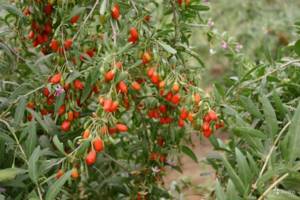
Tibetan Natural habitat - Eastern China, Northern India, mountains of Tibet. Asian barberry is considered one of the most useful plants among all members of the genus. The healing basket of scarlet fruits of the plant is especially famous.
The trees grow up to 3.5-4 meters, the branches grow widely upward and to the sides. The dark green leaves curl into tubes, and the flowers have an unusual purple color.
Goji variety Shambhala . A very thorny shrub, up to 3.5 meters high. It is famous for its famous goji berries, which are credited with healing powers in the treatment of cancer and other dangerous diseases. This barberry grows in any soil except swampy soil.
Canadian (Ottawa)
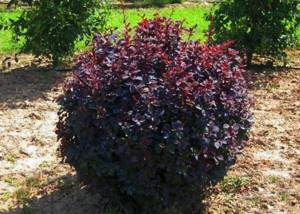
Canadian (Ottawa) Varieties of this species are united by red foliage and a dense, spreading crown. The color of the leaves varies from dark purple to deep scarlet. It is not very widespread in Russia, it is more often found in Siberia and the Urals, due to its frost-resistant qualities.
- Superba . Purple shrub with yellow crown and red berries. It grows quickly and vigorously and requires regular pruning. Unpretentious, drought-resistant.
- Auricoma . Burgundy foliage with silver tints. It grows compactly but voluminously.
- Silver Miles . A low tree up to 3 meters high. Leaf color ranges from purple to burgundy. The flowers are yellow-red, small, and grow abundantly.
Amursky

Amur This type of barberry is found naturally in the Far East, China and Japan. The varieties are usually tall - from 2 to 3.5 meters, the crown is not dense, spreading.
In summer it is bright green with yellow petals. The berries are eaten and medicinal tinctures are prepared from them. The bark is used for mosaic finishing.
Common (evergreen)
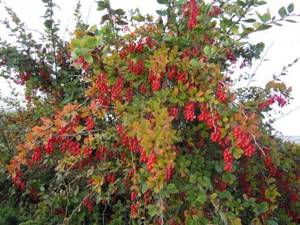
Common (evergreen) Large, slow-growing shrub with narrow, long leaves. They do not fall off in the fall and remain on the branches throughout the frost period. In the spring, when a new crown begins to grow, the old leaves dry out and fall off.
The plant is not afraid of frosts down to -35°C, so it is actively grown in central Russia, Siberia, and the Urals. It rarely becomes the target of pest attacks and does not suffer in organically weak soil.
Grows well in a polluted urban atmosphere:
- Alba variety . A beautiful fluffy shrub with unusual white fruits. Grows in Crimea and the Caucasus.
- Variety Lutea . The light yellow berries are eaten. Abundant fruiting is possible only in a bright, sunny area.
Korean

Korean The plant's homeland is the Korean Peninsula, its rocky slopes, gorges, and mountainous regions. Large ovate leaves are green in summer and turn red in autumn. The spines are flattened, long, thick.
The fruits are bright red, perfectly round in shape, 10-12 mm in diameter. The shrub does not tolerate severe frosts and prolonged thaws.
Types and varieties of barberry with photos and names
There are a large number of types and varieties of barberry, and sometimes it is not so easy for a gardener to make a choice. When choosing a specific type or variety, you need to know exactly what goal you are pursuing and focus on it. If you are going to grow barberries to produce berries, then you should opt for special species. If you need to decorate your garden or create a hedge, then other varieties and types are suitable for this. However, it should be remembered that there are species that can not only become a wonderful decoration for the garden, but also produce a rich harvest of tasty fruits.
Common barberry (Berberis vulgaris)

This species is the main one in this genus. The height of such a bush can reach 300 centimeters. The stems are colored brownish-gray and have tripartite spines two centimeters long. Membranous, thin elliptical leaf plates have a ciliated-serrate edge. Their front side is painted dark green, and their back side is a pale greenish-gray. The length of the racemose inflorescences reaches 6 centimeters; they consist of fragrant glossy yellow flowers. Flowering lasts 14–20 days. There are many rich red berries, which are about 15 mm long. This species has many varieties: albo-variegata - leaf blades of white-variegated color; aureo-marginata - the foliage has a golden border; atropurpurea - leaves are dark purple or red. In the seedless form of barberry asperma, the fruits are very easy to process.
There are several species that have certain similarities with common barberry, for example: Provençal barberry (a hybrid of common barberry and Siberian barberry), spinous - a species from the Himalayas, Canadian, Zimbold's barberry, James's barberry and Diels' barberry.
Thunberg's barberry (Berberis thunbergii)

This is the most spectacular species among deciduous barberries, which stands out for its decorative effect. The height of this shrub can vary from half a meter to a meter. There are horizontally located branches. The deep red or light yellow young stems are arched and branch heavily. Over time, they become brownish-purple or brown. Elastic thin spines are centimeter long. The graceful leaves have an obovate or oblong shape; they reach no more than 30 mm in length. Their front side has a rich green color, and the back side is bluish, and in autumn they change their color to rich red. Flowers can be single or collected in bunches. The inner surface of the petals is yellow, and the outer surface is red. Flowering lasts 7–14 days. The centimeter-long glossy elliptical berries are coral-red in color. They ripen in the first autumn days and become the main decoration of the bush for several months. The fruits contain a large amount of alkaloids, which is why they have a bitter taste, but on winter days birds eat them with pleasure. Planting and growing this species is very simple. This shrub will be an excellent decoration for your garden plot. This species has many decorative forms: multi-flowered (pluriflora), dark purple (atropurpurea), silver-marginated (argenteo-marginata), etc.
The most popular varieties are:

- Golden Ring - reaches a height of 300 centimeters, has a rounded crown. The length of the ovoid leaf plates is about 4 centimeters, they have a dark red-purple color and a yellow border. In autumn they change color to deep red. The centimeter-diameter flowers are collected in bunches (from 2 to 5 pieces), their outer surface is red and the inner surface is yellow. The glossy red-coral fruits ripen in October.
- Red Pilar - columnar form. The bush reaches a height of 150 centimeters, and its crown has a width of about 45 centimeters. The leaf blades are violet-red, and in autumn they become rich scarlet.
- Orange Rocket is columnar in shape. The height of the bush is no more than 1.2 meters, and the width is 0.6 meters. Smooth small egg-shaped leaf plates on this year's stems are orange in color with a yellow edge, while on last year's shoots they are purple-red. Against the background of greenery, such a bush looks very elegant. In autumn, the leaves turn various shades of red.
- Kornik - the height of this deciduous plant is about 150 centimeters. On the surface of the light green leaf blades there are randomly located white-cream spots of various shapes. It looks like the leaves have been splattered with paint. In autumn, the green color of the leaves changes to scarlet red. This variety is recommended to be planted next to conifers, roses or other varieties of barberry.
Ottawa barberry (Berberis x ottawensis)

This decorative hybrid was born as a result of crossing the Thunberg barberry and the atropurpurea of the common barberry. This species is one of the most beautiful representatives of this genus. The height of the bush varies from 150 to 200 centimeters. Externally, such a bush is similar to an enlarged Thunberg barberry, but the color of the leaf blades is similar to the purple-leaved form of common barberry. Thus, the leaves are painted in a dark violet-pink color, which in the sun looks almost black. In autumn, the leaves acquire a crimson color, and they decorate the plant for a long time. This species is characterized by winter hardiness, unpretentiousness, and is also a fast-growing plant.
The most popular varieties are:

- Auricoma is a bush that reaches a height of 250 centimeters. The rounded leaves, five centimeters long, are deep red in spring and summer, and orange in autumn. The length of the racemose inflorescences is about 5 centimeters; they consist of yellow-red flowers with a centimeter diameter. Rich red berries.
- Superba is a bush that can reach a height of 400 centimeters. The length of the rounded leaves is 3–5 centimeters, they have a dark red color with a bluish coating. In autumn, they change their color to different shades of red and orange. Racemose inflorescences consist of red-yellow flowers. The fruits are red.
- Silver Miles - this variety does not look attractive when viewed up close, but when viewed from afar, it is very impressive. On the surface of the purple leaves there are randomly located streaks of dirty gray color. If you look at the bush from a distance, it seems that it is painted lilac.
Also quite popular are barberries such as: Juliana, Beana, Tischler, Morrison, Wilson, greenish, willow, multi-flowered, oriental, Iberian, reticulate, similar, dove-white, boxleaf, notched or unedged, large-thorned, provincial, spring, Ili, coin, Korean, Tibetan, Siberian, transparent, round-serrated, twisted, Amur, Turkmen, whole-edged, oblong, round-fruited, Asian, etc.
Planting in open ground
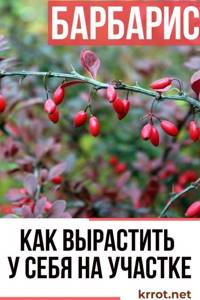
The plant is planted in the spring, with the onset of the first warm days. It is important that the buds on the shoots have not yet blossomed. The shrub takes root well and rarely dies when planted.
If you purchased seedlings with a closed root system, they can be planted in the fall, a month before the onset of frost, no later than mid-October. Such a shoot grew in a special container, its roots are well formed, not exposed, and are in their native earthen coma.
Therefore, it will survive the winter well, especially if you additionally wrap the young bush with branches and throw snow on top.
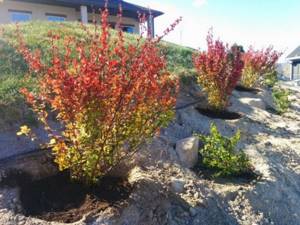
Planting barberry bushes
For rich color and picturesqueness of the future shrub, you should choose a sunny place for planting. Barberry grows in the shade, but the color of the foliage becomes dull, the bright leaves turn green. Individuals with multi-colored shades on the petals and crown are especially light-loving.
The soil can be sandy, rocky, clayey - it is important that it is not excessively moist, as happens in wetlands. To prevent moisture from stagnating in the roots, take care of a good drainage layer. Broken brick, pebbles, crushed stone, and any medium-sized stones are suitable.

Shrub seedlings
Step-by-step instructions for planting barberry:
1The hole is dug 10-14 days before planting. The optimal size is 50*50*50 cm. If you plan to plant several plants, the distance between the holes should be 1-1.5 m. For a hedge – 0.5 m.
2Fill up a small amount of sand and lay drainage.
3Add a layer of mixed soil and humus.
4For additional nutrition, add 100 g of simple mineral fertilizer based on phosphorus.
5 Place the seedling vertically and carefully straighten the roots.
6Fill with soil up to the level of the neck of the root system. Lightly press down the soil. The bush must be tightly fixed.
7The top layer of soil is mulched with organic material. This layer will additionally fertilize the soil and maintain the desired temperature and humidity in the root system. Reception allows you to improve air-gas exchange, which facilitates the nutrition of the newly grown shrub.
8The final stage is watering the plant and trimming the tops of the shoots. Leave 5-7 buds for growth to begin.
Planting barberry seedlings
Planting of seedlings begins in the spring, when it is warm enough outside and there is no risk of night frosts. In this case, the buds on the shoots should remain dormant.
Due to their high survival rate, shrubs rarely die. When purchasing planting specimens with closed roots, autumn planting of barberry can be done 30 days before frost. This specimen was kept in a special container, so its root system is already formed and is not afraid of moving into open soil.
In order for the future shrub to have a rich color and decorative effect, it is important to choose the most illuminated areas of the garden. Certain types of barberry are not afraid of being in shady conditions, but in the absence of light they fade and lose their bright color. Specimens with multi-colored shades on the petals and crown need the most abundant lighting.
There are no special restrictions when choosing soil for planting seedlings. The shrub grows well on sand, rocky or clay soils, as well as on combined substrates. The main thing is that the land is not swampy, because... Excess moisture leads to rotting of the root system. A good drainage layer will prevent the problem.
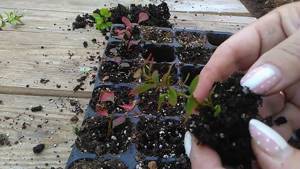
The following materials are used to create it:
- Pebbles.
- Brick.
- Crushed stone.
- Stones with different fractions.
- Construction garbage.
Planting seedlings is carried out according to the following instructions:
- Construction of the recess begins 10-14 days before disembarkation. The optimal parameters of the pit are 50 x 50 x 50 cm. If several plants are expected to be planted, the distance between the pits is chosen at the rate of 1-1.5 cm. When organizing a hedge - 50 cm.
- Next, sand is poured into the hole and a drainage layer is made.
- A substrate of humus and mixed soil is poured onto the bottom.
- In order to saturate the soil with nutrients, use 100 g of mineral fertilizers containing phosphorus.
- The seedling is fixed vertically, carefully straightening the roots.
- Then it is covered with soil to the level of the root neck and the soil is slightly pressed down with your hands. It is important to make sure that the bush is securely in the ground.
- The top part of the soil is covered with a layer of organic mulch. It is intended to additionally fertilize the substrate and maintain optimal root temperature. Mulching also improves air exchange and promotes good nutrition of the bush.
- Finally, you need to water the bush and trim the tops of the shoots, leaving 5-7 buds.

If you want to grow barberry from seeds, you need to properly prepare the seed or purchase it at a gardening store. In the first case, barberry seeds are extracted from ripened berries and passed through a sieve to separate the pulp.
We recommend that you familiarize yourself with Barberry and pilaf
They also need to be treated with a weak manganese solution and washed with clean water. Then the seeded specimens are poured into a tray with damp sand and kept in the refrigerator until spring. Under such conditions, the seeds will be stratified for planting in open ground.
General recommendations for plant care
Despite its unpretentiousness and the absence of special care requirements, in order for barberry to please the eye with a picturesque view, you should follow simple rules of watering, pruning, feeding, pest and disease control.
Watering rules

The shrub is not moisture-loving
The plant is not moisture-loving. In the cool summer period, seasonal precipitation is enough for it. If dry, warm weather sets in, water the bush once every 2 weeks. 10-15 liters of water is enough for an adult shrub and half of this measure for specimens of the first year of life.
Young seedlings need to be moistened 1-2 times a week until complete rooting. You can check whether watering is needed by lightly digging the top layer of soil. If it is dry, add water; if it is wet, wait a couple of days.
Pruning rules
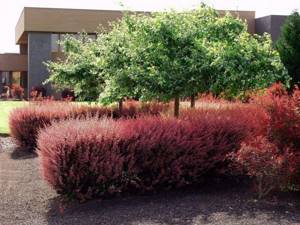
Regular pruning can give your shrub a beautiful shape.
In order for the shrub to grow beautifully, acquire an aesthetic shape and a graceful appearance, it must be pruned regularly. This procedure is performed not only for decorative purposes. In March and October, sanitary pruning is carried out to remove diseased, dried or damaged branches.
The young tree is not pruned in the first year. The first procedure is performed in the second spring, before the buds swell. At the end of summer, the aesthetic appearance of the plant is further adjusted.
Some low-growing varieties have a very dense and dense crown that grows in a regular cone or column. If broken or unhealthy shoots are not visually observed, the plant is not pruned.
Fertilizer and feeding
During the first 3 years of life, barberry only needs the mineral supplements that were added to the soil during planting. An adult plant is fertilized with urea in the spring. This is a fertilizer with a high nitrogen content, which stimulates active growth, promotes rich foliage color, and the formation of a lush crown.

What does urea look like?
Instructions for preparing urea: the product is diluted in proportions - 30 g of dry composition per 10 liters of water.
In the summer, when the plant has finished flowering, it is additionally supplied with any fertilizer with a phosphorus-potassium base. It will strengthen the roots and catalyze the ripening of berries. Has a beneficial, nutritional effect on the soil.
The feed is diluted strictly following the instructions.
Probable diseases
Barberry has excellent immunity to many diseases that plants encounter in the country. It rarely gets sick, is resistant to pest attacks, and does not depend on sudden temperature changes. However, if you overdo it with watering, the process of rotting may begin in the roots, and fungus may appear on the trunk.
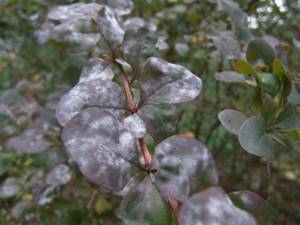
Powdery mildew on leaves
Let's look at common barberry diseases and ways to combat them:
1 Among the pests on the foliage you can find aphids and sawflies, and berries are sometimes affected by moths. If the number of insects is small, the bushes are treated with dishwashing detergent: add 3 tablespoons of soapy substance to 1 liter of water and spray from a distance of 0.5 m. If there are a lot of pests, purchase the preparations “Aktellik”, “Karbofos”, “Aktara”.
2 Sometimes the branches are affected by a fungal coating, which is called “powdery mildew”. Outwardly, it looks like white spots, as if sprinkled with flour. Diseased shoots are cut off and burned. The shrub is treated with fungicides.
3 The same substances will save barberry from rust and bacterial cancer. The first appears as red smudges and spots on the tree trunk. The occurrence of the second is indicated by numerous cracks and growths.
In advanced cases, they do not spare the plant and uproot the entire bush. Otherwise, there is a risk of infection of other garden crops. All affected branches are destroyed at the stake.
Wintering
Despite the frost resistance of most species and varieties of barberry, young plants need to be covered for the winter. This applies to specimens under 5 years old. A thin and insufficiently strong root system may not tolerate the cold and die.
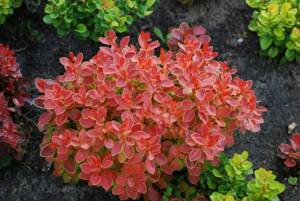
Young barberry needs to be covered for the winter
In regions with severe frosts, mature bushes are also wrapped. A hut-like structure is made from spruce branches and dry branches. When snow falls, it is additionally thrown onto the roof of the makeshift house.
Recommendations for planting and caring for Thunberg barberry
Landscape design > Plants > Shrubs
Barberry thunberg is a shrub of the deciduous barberry family, the direction of growth is horizontal. Japan and China are considered to be the birthplace of this plant. Many varieties of barberry thunberg have green leaves and bright red berries. Some can even boast leaves of red, white-green and even yellowish hues. The tallest type of barberry reaches three meters in height, the lowest, belonging to the dwarf species, can grow only 20 centimeters. Read what David's budleya looks like and how to prepare it for winter.
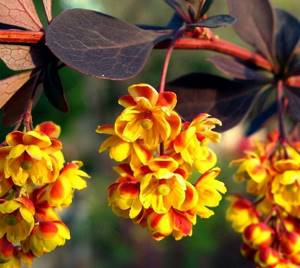
This is how one of the Thunberg barberry varieties blooms
All types of Thunberg barberry take root well in the garden, some of them are used only for decoration, and the largest ones can even serve as a hedge. This plant develops quite quickly, needs sunlight, and is frost-resistant. It is worth considering the fact that it is necessary to plant barberry only in places where gusty winds cannot harm it. An overview of weigela species here: https://landscapediz.com/rasteniya/kustarniki/obzor-sortov-i-vidov-vejgely.html.
Thunberg barberry bears fruit every year, but for this it is necessary to care for it accordingly.
When to plant Thunberg barberry?
If barberry is planted as a separate unit, then it is necessary to leave a distance of one and a half to two meters between the bushes. If Thunberg barberry is used as a dense single-row hedge, then it is necessary to place about four specimens in succession. At this distance, the barberry will eventually grow and occupy the entire territory allotted to it. If the hedge is planted in two rows, then it is necessary to plant about five bushes, so the row will be denser and even more impenetrable. To correctly calculate the number of bushes, there are proportions: 2 copies per 1 linear meter.
Barberry of this species is able to withstand high acidity of the soil; it can be either absolutely neutral or acidic, but the shrub still gives preference to neutral. Thunberg barberry should be planted in a soil mixture of the following composition (all ingredients are mixed in a 1: 1: 1 ratio):
- sand,
- humus
- garden soil, which can be purchased at any gardening department.
If the plant is planted in acidic soil with an acidity of 6-7.5 pH, then it is necessary to add limestone.
The bush should be sprinkled with 300 grams of slaked lime or two hundred grams of wood ash. Find out how to care for Thuja Smaragd on this page.
It is not recommended to plant Thunberg barberry in the autumn, because the plant needs to strengthen, develop a root system and prepare for the onset of cold weather. And in the fall there is no time for this. Accordingly, many young shrubs may simply not survive the winter cold.
How to plant Thunberg barberry correctly?
To properly plant Thunberg barberry, you must follow the following tips:
- The cuttings that will be planted in the soil mixture should be sprinkled with substances responsible for the rapid growth of the plant. Growth accelerators can be purchased in the garden departments of any shopping center.
- Prepare the soil in advance. If groundwater was previously observed at the landing site, then drainage should be done.
- Expanded clay or crushed stone is perfect for creating drainage; you need to sprinkle the drainage with sand on top.
- After the bush is placed in the ground, it should be thoroughly watered and a “steam bath” should be arranged for a while.
The bath will provide the plant with comfort during the period of formation and strengthening of the root system. - It will be necessary to water the young shrub as it dries; a clear sign of a lack of moisture can be considered a dry cobweb at the base of the plant.
How to propagate Thunberg barberry?
Barberry Thunberg can be grown either from seeds or from cuttings. The second method is the most convenient because it takes less time and is not so labor-intensive. Read about the characteristics of Thunberg's barberry here: https://landscapediz.com/rasteniya/kustarniki/xarakteristiki-barbarisa-tunberga-i-foto.html.
To get a cutting from a bush, you should:
- cut off three or four branches, the presence of green shoots on which is mandatory.
- clear leaves from branches
- at an angle of 45 degrees, divide them into two more,
- Treat all sections with a growth accelerator.
The next step is to place the cut pieces in a container with liquid. A small transparent container is suitable for this; the top is covered with mesh material (for example, gauze) and the blanks are stuck in. This way you can observe the formation of roots on the cuts.
First you need to split off part of the bark at the very edge of the cut.
The sprouted branches are transplanted into pots with a soil mixture similar in composition to that for planting. After rooting, the plant is planted in the soil.
Caring for Thunberg barberry
Proper care of barberry will give you the opportunity to see a completely healthy plant all year round, which not only develops but also bears fruit. To do this, you need to regularly feed barberry. Feeding begins from the age of 2, and nitrogen fertilizers are applied in the spring. Urea is perfect for this, which is pre-diluted in a bucket of water (proportions 20-30 grams per bucket). Then you should fertilize the bush several times a year with complex fertilizers with microelements.
Shrubs are watered once a week; barberry does not like much moisture, but as for loosening, special attention should be paid to this point, because weeds often interfere with the normal development of the bush. After the plant is planted in the soil mixture, it will be necessary to mulch.
Every year you should not only feed and water the plants, but also prune them. You can properly prune the plant as follows:
- first remove weak shoots,
- after - those that have developed poorly.
In this way, the gardener allows more viable shoots to develop.
Adult bushes should be replanted in the spring; if the plants are planted with a dense single-row hedge, the bushes can be pruned only after 2 years. You should cut off one-half to two-thirds of the above-ground part of the fence. You can prune twice a year: at the very beginning of summer and at the end of August.
As for dwarf barberries, pruning them is completely optional; they are excellent for zoning a garden plot. In temperate latitudes, barberry shrubs are often used as hedges. If you take several different varieties to create a fence, the fence will turn out not only impassable, but also incredibly beautiful. In some varieties of barberry, the spines reach one and a half centimeters, so sometimes it is even more dangerous than the hawthorn itself.
Barberry Thunberg, pests and diseases
The main diseases of Thunberg barberry:
- Powdery mildew is a fungal disease that manifests itself as a white coating on the entire trunk of barberry. To get rid of the “sore” you need to spray the barberry with a solution of colloidal salt. Barberry aphid - this disease can lead to either partial or complete loss of foliage. Spring spraying with a solution of laundry soap is perfect against this type of disease.
- Rust. It does not affect this species of the barberry family.
Video
Watch video tips on using Thunberg barberry in landscape design:
Barberry Thunberg is suitable for those gardeners who like to tinker in the garden. They love to spend time caring for and watering. For those who are not ready to spend personal time on a garden plot, barberry will bring little joy. In addition to thorns, an unkempt plant will not only spoil the entire composition of the garden, but will also contribute to the germination of various weeds and unpleasant-looking plants. In order for the garden to please the eye, you must first invest your heart and spend a lot of time. Read recommendations for growing thuja occidentalis Brabant and its use in landscape design.
Reproduction methods
Barberry is bred using all methods known in botany: cuttings, seeds, layering, dividing the bush. The plant takes root equally well when using any of them.
Let's look at each process step by step:
Cuttings
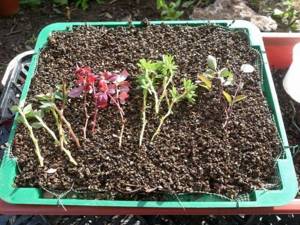
Propagation by cuttings
The method requires constant care of the cuttings.
1At the beginning of summer, fresh shoots 15-20 cm long are cut to obtain cuttings.
2Foliage is removed from below, the cut is treated with any phytohormone.
3The top leaves are cut to half.
4The cuttings are planted in soil made of humus, peat and sand poured into a greenhouse container. A trunk 1/3 of a branch long remains outside.
5The seedlings are watered, covered and ventilated daily.
6They grow in a greenhouse for less than 2 years. In the second spring, seedlings are planted in open ground.
Layerings

This is what propagation by layering looks like
One of the simplest and least labor-intensive methods.
1With the onset of spring, choose strong shoots growing in the lower part of the outer circle of the bush.
2They are bent to the ground and placed in specially dug trenches with drainage, 0.5 m deep.
3Secure with staples, sprinkle soil on top, and mulch.
4Don’t forget to water and feed regularly, just like the mother bush.
5After a year, the branches are cut off from the parent with pruning shears, dug out of the ground along with the formed root system and replanted for growing.
6 Another year later, in the spring, fresh barberry shoots are planted in a permanent place.
Seeds
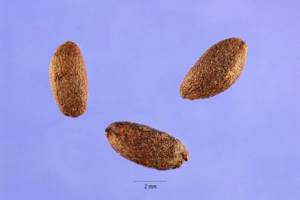
Barberry seeds
Barberry seeds have a high level of germination.
1In early autumn, the fruits on the bush ripen. They are collected and washed. Every other day, wipe and lay out to dry.
2In the same autumn, a month before the onset of frost, the seeds are planted in open ground in furrows 1-2 cm deep.
3For the winter, the bed is covered with spruce branches.
4In the spring, when the shoots appear, they are thinned out. Leave one seedling every 3-5 cm.
5During the summer, do not forget to regularly water, loosen, weed and fertilize.
6With the onset of the second spring, the seedlings are planted in permanent places.
Please note that with this method of reproduction, young barberries may not retain the characteristics of the mother.
Dividing the bush
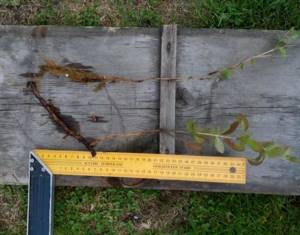
Reproduction by dividing the bush
For this method, it is necessary to select plants no older than 5 years.
1In the spring, with the onset of settled warm weather, a young bush is dug up. The buds should not swell yet.
2Use a pruning shear to cut the root system so that at least 3-5 shoots remain on each side.
3The cut site is treated with charcoal and immediately planted in a permanent place.
4Water, mulch, fertilize according to plan.
5Barberry division is used only for propagation of dwarf shrubs. For example, varieties of domestic plants.
Recommendations for breeding indoor varieties
At home, low-growing varieties of the Thunberg species grow best. They respond well to frequent decorative pruning, so such plants look aesthetically pleasing and elegant.

Miniature variety Bagatelle
The following varieties are perfect for the home:
- Natasha . Variegated foliage with tints of white, pink and green looks unusual on pinkish branches. An unpretentious plant that grows slowly.
- Erecta . The leaves are regularly rounded and green in color. The bush is decorated by an even, columnar crown that does not grow higher than 80 cm.
- Bagatelle. Dense, spherical shrub with bright purple leaves edged with green. The height of an adult plant does not exceed 30 cm.
For indoor barberries you should choose universal soil . Don't forget to put drainage on the bottom. Watering is done twice a week in summer, autumn and spring, and once in winter.
Spray regularly with water, excluding the flowering period. The pot is placed on the sunny side, with a constant flow of fresh air.
Choosing a barberry variety
In addition to its decorative purpose, barberry produces large harvests of berries, which are used in cuisines around the world. Landscape designers value the plant for its lush foliage and unpretentious conditions.
Some varieties grow normally in our regions and can withstand prolonged drought or exposure to low temperatures. Barberry is propagated in various ways, and it does not require frequent feeding and is protected from most diseases.
Among gardeners, the plant is often called a candy bush, since in Soviet times confectioners produced delicious treats bearing its name.
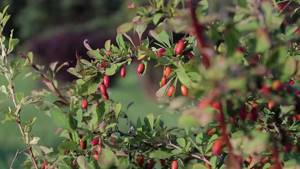
According to crown type, varieties are:
- Evergreen.
- Falling.
- Deciduous.
The foliage grows in bunches in a regular order, and the leaves are directed with spines upward.
The height of the bush varies from 30 cm to 3 m, depending on the varietal characteristics. The crown of adult specimens has a columnar or spherical outline. Life expectancy is 35-50 years.
The beginning of flowering occurs at the end of spring or the first weeks of summer. During this period, the plant becomes covered in bright shades (purple, red, yellow, green, purple). After 2-3 weeks, the flowering elements disappear, and by the end of summer, oblong berries form on the bush. Their color is red, black or burgundy.
The fruits are highly resistant to environmental influences and can hang on barberries even in winter. A large number of varieties are considered valuable honey plants. Barberry honey is characterized by a medium consistency, pleasant aroma and taste, and a golden hue.
When planning to grow barberry, it is important to decide on its variety. Today, the genus includes about 600 varieties of shrubs, and many of them are intended for decorative purposes. These include both giant specimens and stunted species. In addition, in addition to ornamental plants, there are edible and pharmacological subspecies.
For Russian conditions, it is customary to use frost-resistant and unpretentious varieties.
Some gardeners prefer planting Thunberg barberry. In the wild, this deciduous shrub grows in China and Japan. The palette of its shades is represented by red, orange, green and yellow tones. Representatives of the species are not afraid of frost or dry weather, are well protected from pest attacks and grow on any soil without fertilizing.
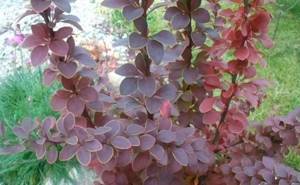
Among the popular varieties from the Thunberg group are:
- Erecta. It is an upright plant with a pyramidal crown shape and green oval leaves. An adult grows to 1.2-1.5 m in height. The flowers are yellow or pale red.
- Admiration. A dwarf bush with a round top with a diameter of up to 1 m. The maximum height does not exceed 50 cm. The leaves are yellow, red or orange in color.
- Coronita. The variety is characterized by a neat crown and vertical shoots. As it matures it grows up to 1.5 m.
- Golden Rocket. A yellow plant with a pyramidal shape that grows to 1-1.2 m in height. Characterized by lush green-yellow foliage and vibrant blooms. Suitable for most Russian regions.
- Harlequin. This wide bush is characterized by a spreading crown (up to 2 m) and purple foliage with white and yellow splashes. It is not afraid of negative temperatures or drought, but requires pruning procedures to correct its shape.
- Barberry Thunberga Atropurpurea. Representatives of the variety are distinguished by purple leaves and an oval crown. During flowering, they are covered with yellow-purple flowers, and at the stage of fruit ripening they produce coral berries.
- Barberry Aurea.
When choosing Thunberg barberry, it is best to plant it in a prepared bed with a high nutrient content and plenty of light.
Another species suitable for planting in spring or autumn is Tibetan (Asian) barberry. Under natural conditions, it grows in the forests of Eastern China, in the mountains of Tibet and in northern India. It has many beneficial properties and is used for medical purposes. The height of mature trees reaches 3.5-4 m.
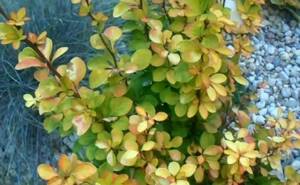
The shoots grow upward and to the side, and the dark green leaves curl into tubes. The surface of the flowers takes on an interesting purple hue. Among the popular representatives of the species is the Goji Shambhala variety. The shrub has many small spines and grows up to 3.5 m in height. Goji berries are considered to be of particular value, as they have numerous healing properties. Barberry grows on any soil, except swampy.
Another popular variety is Canadian barberry. Varieties from this group are distinguished by the red tint of their dense foliage, spreading crown and different colors.
It is not widespread in Russia and is found only in the Urals or Siberia.
The group includes the following varieties:
- Superba. A large shrub with purple shoots, a yellow crown and large red fruits. It is characterized by fast and active growth, but requires pruning.
- Auricoma. It has burgundy leaves with silver tints.
- Silver Miles.
For home cultivation, you can use another species - Amur. It grows in the Far Eastern countries and China. The maximum height reaches 2-3.5 m. In summer, the bush becomes bright green and covered with yellow petals. Its berries are suitable for eating or preparing medicines. The bark is intended for creating finishing materials.
We recommend that you read Treatment for pests of currants and gooseberries
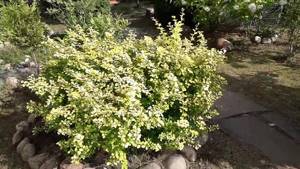
In the Moscow region and mid-latitudes of Russia, common barberry with evergreen foliage is grown. Being a slow-growing plant, the shrub retains its leaves throughout the winter, and with the onset of the spring season it begins to shed them. The plant is not afraid of frosts down to -35°C, which is why it is suitable for Siberian or Ural conditions. Unlike other varieties, it is not afraid of attacks by harmful insects and diseases. Suitable for keeping in urban environments.
Popular varieties include:
- Alba. Lush bush with white berries. Found in the Caucasus and Crimea.
- Lutea. It has light berries with a pleasant aroma and taste. Good yield is noticeable only in illuminated beds.
Features of planting in different parts of the country
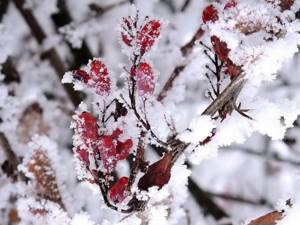
Amazing winter spectacle
When choosing a suitable variety, they are guided by the weather conditions of the region and the characteristics of the plant’s resistance to them.
1 The mild winters of the Mediterranean, southern regions of the Caucasus and the Black Sea coast make it possible to grow almost any type of barberry. The warm climate promotes favorable growth, abundant flowering and fruiting.
2 The temperate continental climate of the central part of Russia is characterized by hot summers and mild winters with temperatures down to -20-25°C. It is better to wrap the barberry for the winter, and in the summer do not forget to water it when there is no rain.
3 In areas with a high content of groundwater in the soil , which includes the Moscow region, when planting, do not forget about the drainage layer. Its height should be 1/3 of the depth of the planting hole.
4 Frost-resistant barberry varieties take root well in the Urals and Siberia Young plants here are necessarily covered with spruce branches and covered with snow. For those less resistant to the cold, a greenhouse is built.
How to care for Thunberg barberry
After planting, the bush will need watering every 10 days until the young growth takes root. As well as winter insulation for the first 2-3 years of life in a new place. Mature shrubs tolerate wintering quite calmly, so they do not need shelter and can withstand temperatures down to -35 degrees.
In the spring, the plant must be pruned and dead areas, old, deformed, and mold-infested branches removed, and the crown trimmed if necessary. In all other respects, there are no special problems or any specific actions.
During periods of severe drought, root watering is carried out. The rest of the time, the bush has enough natural precipitation. Periodically loosen the soil to provide oxygen to the roots and remove weeds. Treatment against insects and infections is carried out in accordance with the instructions of the drug in case of damage to the crop. In the fall, apply root mulching with a thick layer of organic matter: compost, peat, humus.
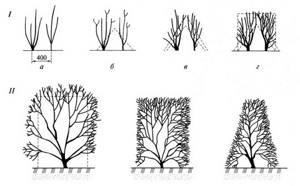
Step-by-step bush formation
Use in landscape design

Barberry in landscape design
The variety of colors of barberry foliage and trunks, the decorative shape of the crown and unpretentiousness to urban conditions have determined the frequency of use of different varieties of shrubs in landscaping and landscape design.
It looks spectacular at any time of the year. In spring and summer there is fresh greenery, in autumn there is a fiery fire, and in winter bright fruits decorate the faceless snow-white garden.
A fantastic combination of shades makes the bush stand out equally well both in a single planting and in a group planting, where it often acts as the center of the composition. Hedges made from barberry look gorgeous, especially from several varieties with different crown colors.
The shrub lends itself well to pruning, pliably takes the desired shape, and grows correctly in the indicated direction. Using it, picturesque ensembles are obtained that delight the eyes of passers-by in city squares and parks.
About popular varieties of decorative barberry
The ancestor of all varieties of this plant is the Purple barberry. Breeders began to develop decorative forms of shrubs 100 years ago.
There are now more than 50 species of Thunberg barberry in the world, and their number continues to increase every year. Among them are shrubs with green, purple, orange, yellow and variegated foliage.
Red-leaved barberry will add expressiveness to your garden. There are several varieties of the plant that have purple-red leaves that turn bright carmine in the fall. The very first of them was the Atropurpurea variety.
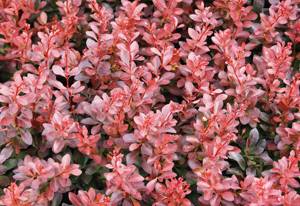
This is a fairly tall plant, up to 1.5 m, frost-resistant. It can be planted either as a hedge or in combination with other shrubs in a garden or summer cottage.
Barberry Thunberg Golden Ring (Golden Ring) foliage is also purple, but it has a golden-yellow edge, which greatly decorates the plant.
The effect of the magnificent appearance of Golden Ring barberry will be greater if you plant it as a single bush.

The variety is resistant to light frosts, but is not suitable for cultivation in harsh climates. In central Russia, breeders recommend covering Golden Ring for the winter.
The low-growing Aurea species is very popular among gardeners. Its leaves are golden or lemon-colored in summer and turn orange-yellow in autumn.
The type of barberry Thunberg Aurea is simple to plant and care for. It does not like direct sunlight as its lemon foliage may burn.
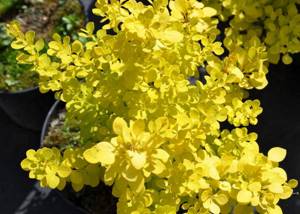
This shrub will feel better in partial shade. Aurea looks good against the background of red-leaved varieties of barberry or greenery.
Plants with variegated leaves will also add charm to your garden. Among them is a fast-growing shrub of the Flamingo variety, up to 1.5 m high.
Its purple leaves have silver and pink spots. The plant is planted near ponds or combined with the Aurea variety.
The Rose Glow shrub will also delight you with its rainbow-colored foliage. Its fresh foliage includes purple, red and gray colors. In autumn, the leaves look like pieces of dark red marble with gray streaks.

The plant reaches a height of 1.5 m and has a very spreading spherical crown. Suitable for alpine slides or hedges.
The new low-growing barberry variety Thunberg Select has green foliage with white streaks in spring and summer; in September it turns orange-red.
The plant is well suited for rocky gardens and looks great in the foreground of taller plants.
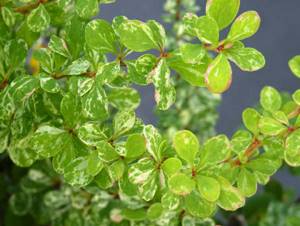
Gardeners in whose areas there are severe frosts should consider growing this variety. The variety is highly cold-resistant.
In the Kornik barberry, the leaves retain their green color with stripes and cream-colored spots until cold weather.
The plant can be combined with any shrubs. Barberry Thunberg Kornik is known to be weak to severe frosts, so it needs shelter for the winter.
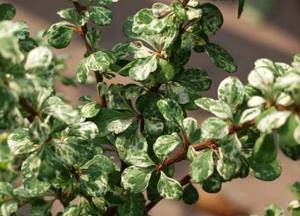
Application of fruits, foliage and wood
In addition to its chic appearance, the plant is famous for its dense and textured wood . Some of its types are used in turning, as a material for openwork inlay. The wood of many varieties has a rich red, burgundy, yellow or purple hue, so it is actively used for laying out Indian mosaics.
Souvenirs, crafts, and toys are made from solid trunks . They are used to make shoe nails. And from the yellow bark and rhizomes, natural yellow paint is obtained.
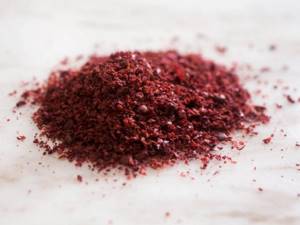
Seasoning made from dried fruits
In Tibet, crushed and dried fruits are added to spicy mixtures. In the east, barberry seasoning is used everywhere. It is added to meat fillings, pilaf, and stewed meat dishes.
Due to the content of malic, tartaric and citric acids in unripe fruits, they make excellent marinade and sour sauces. In confectionery, berries are used to make preserves, jams, marshmallows, marmalade, jellies and mousses. Compotes are made from them and exquisite liqueurs are pressed.
Fresh leaves are used to make sour soups, chop them into salads, and add them to canned food . Valuable and healthy tea with barberry flavor is obtained from dried fruits and herbs. In the cosmetology industry, oil extract from fresh barberry berries is added to creams, lotions for hair and face.
Healing properties
Since ancient times, barberry has been known as a plant with a rich healing potion. Its fruits, bark and leaves contain a lot of nutritious biological substances and beneficial microelements.

Medicinal tea
The medicinal properties of the bush are used in pharmacology, folk and traditional medicine:
- A decoction of the fruits of the plant has a hemostatic function. Regular use normalizes blood pressure and strengthens blood vessels
- barberry compote is famous as an effective antiviral agent. It is good for respiratory diseases
- Plant-based medicines normalize metabolic processes, remove waste and toxins. They increase appetite and help food digest properly
- there are studies proving the effectiveness of barberry treatment of malignant cancer diseases
- tea eliminates headaches, improves mood, acts as a good anti-stress remedy
Specific substances in the composition may cause an allergic reaction.
Tasty and healthy fruits will improve the health of the whole family, and homemade seasoning from dried berries will give new dishes a refined and unusual taste.
The plant is included in the list of components that promote healthy longevity.
Planting barberry in your garden is something even a novice gardener can do. Minimal care for most varieties will not cause any trouble and will not take much time. The picturesque coloring of the shrub will delight you with its appearance all year round.
Watch a short video about simple rules for planting a candy plant:
